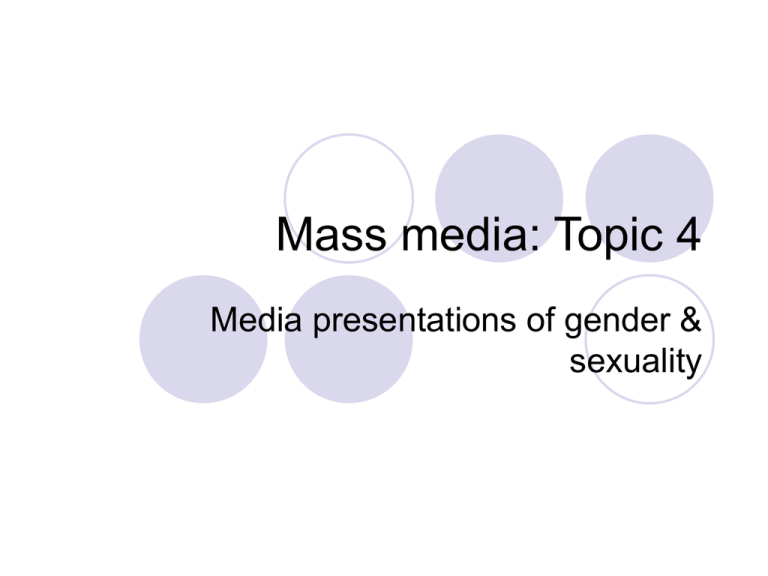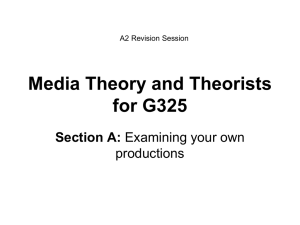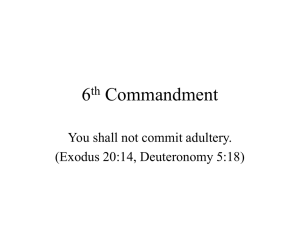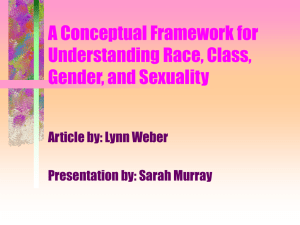
Mass media: Topic 4
Media presentations of gender &
sexuality
1.
2.
3.
4.
5.
Gender & sexuality are 2 separate issues; gender referring to
being male/female; sexuality referring to being
heterosexual/homosexual.
Tunstall says the presentation of women in the media is biased
because it emphasises women’s domestic, sexual, consumer &
marital activities to the exclusion of all else.
Despite there having been improvements in women’s position in
society, the way they are represented in the media has been
criticised for the following reasons:
Allocated a limited range of roles
Less visible within the media than men
Presented as ideals
Selected to appeal to men
Men seen as aggressors, women as victims
Women in a limited range of roles
Whilst men perform the full range of social & occupational roles within
media representations, women are found to be in a narrow range of roles.
Women particularly found in domestic settings – as busy housewives,
contented mothers, eager consumers.
Tuchman also points out that women have sexual & romantic roles.
Women less likely to be shown in high status occupational roles, such as
doctors & lawyers; and when they are, they are often portrayed as
unfulfilled, unattractive, unstable, probs dealing with relationships, with their
kids getting into trouble due to their focus on their career. Men rarely
portrayed this way!!
Tunstall says that men’s domestic & marital roles largely ignored (are they
not fathers); women’s roles in paid employment also largely ignored –
despite over paid being in paid employment.
In more recent times we have to acknowledge that there has been an
increase in stronger roles for women – Sex And The City; Tomb Raider.
What does this indicate about the media?
Women being less visible
In 1990, Cumberbatch found 90% of voice-overs for tv adverts were male. Was this
because the male voice was seen to represent authority & wisdom? 66% of people
appearing in adverts were male & females who did appear were likely to be young,
blond & not in a workplace setting.
In the 1990s, women were the main stars of only 14% of tv programmes.
Women also absent from the top jobs in the media (executive positions).
In 1992, there were no female sports editor on national or Sunday newspapers.
More recently, we do see a change & women are more present; still not equal though.
Female issues often marginalised within the media. This means issues concerning
women are forced out of the mainstream. Evidence of this is that most newspapers
have ‘women’s pages’ which focus on women as a special group, with special (often
emotional) needs. These pages tend to concentrate on beauty, slimming &
relationships.
Tuchman uses the term ‘symbolic annihilation’ to describe the way in which women in
the media are absent, condemned or trivialised.
Symbolic annihilation basically refers to the under-representation of women in media
texts, particularly tv, so that they become virtually invisible.
Women as ideals
Ferguson conducted content analysis of women’s magazines from 1949 to 1980 &
found that such magazines are organised around a ‘cult of femininity’.
This promotes an ideal where excellence is achieved through caring for others,
marriage, family & appearance.
We must be aware that modern female magazines are moving away from these
stereotypes; although Ferguson argues these still concentrate on ‘him, home &
looking good.’
Winship has a less negative perception of magazines & stresses the supportive roles
that such magazines play in the lives of women.
She believes they tackle problems that have been largely ignored by the male
dominated media, such as domestic violence & child abuse.
In relation to film & tv presenting, most women tend to be under 30 & have a certain
look. Physical looks, sex appeal & youth seem to be necessary attributes for women
to be successful in the media. Is this the same for men?!!
Wolf points out that the media, particularly advertising, present a particular physical
image as the normal or ideal body image for women to have – even though this body
image is unattainable for most.
Orbach & Woolf have linked such distorted & idealised images to anorexia & bulimia
in teenage girls.
Women selected to appeal to men
Women often presented as sexual objects to be enjoyed by men.
The extreme media version of this is pornography & page 3 girls in
newspapers (now called glamour models!!)
Mulvey argues that film-makers employ a ‘male gaze’, where the
camera basically ‘eyes up’ the female characters. Films like
Striptease, Basic Instinct & Showgirls are blatant examples of this.
Male style mags (FHM, Maxim & Loaded) do encourage males to
dress a certain way & follow the latest look, however there is less of
a burden to on them to change themselves to conform. However,
some would say the content of such mags indicates the ‘new man’.
Whereas through the media women are often made feel they need
to conform to ensure they are viewed by males as desirable. They
feel the pressure to buy the latest ‘must have’ item & get that ‘bikini
bod’.
Research males & magazines
Men as aggressors, women as victims
During the 1980s, films like Rambo, Die Hard & Commando
presented males as tough & capable of saving the world. The lead
roles in these films presented a very physical & threatening form of
masculinity.
More recently, male violence in cinema has become more stylish
with Snatch, Lock Stock & Two Smoking Barrels.
In popular shows like CSI women are often the victims of violent &
sex crimes, adding to the notion that all women are potential victims
& vulnerable to the superior strength of men.
Smith says that female fear of violent assault is often the basis for
many top movies, within which women need protected by other
males.
Examples?
Liberal feminist perspectives of media
representations
They are concerned about media representations
because they believe the mass media plays a major role
in the social construction of gender roles; how kids learn
to be masculine & feminine.
They are particularly concerned about the emphasis on
women as domestic goddesses and sex objects. Why?
Because this can limit female aspirations & behaviour.
Lib fems accept the trivialisation of women has lessened
due to greater number of female journalists, editors etc.
Lib fems still concerned about lack of women’s progress
in media professions.
Socialist/Marxist feminist perspectives
Roots of the stereotypical images of men &
women in the media are economic.
Media (mags) make profits from advertising & so
promote false needs around beauty, fashion,
anti-ageing etc in order to attract advertising
revenue from such industries.
Women’s anxieties about weight & age are
deliberately exploited by the media so they
continue to be consumers of body-related
products.
Radical feminist perspective
Media reproduces patriarchy; traditional images
deliberately transmitted by male-dominated
media to keep women in a narrow range of
roles.
Media dupe women into the beauty myth & see
this as their central goal, rather than compete
with men for positions of power.
Men’s mags that encourage retributive
masculinity are a backlash against the gains
made by women. They want women to remain
as subordinate sex objects.
Popular feminist perspective
According to McRobbie, much of young
women’s media today constitutes a form of
popular feminism.
Popular feminism describes the promotion of girl
power in female mags.
Hollows says popular culture in the form of
women’s mags is a site of cultural struggle
where new forms of feminism are being defined.
Postmodernist perspective
Postmodernist thinker, Hermes, thinks people can respond to media
images & stereotypical portrayal of women in a variety of ways.
Individuals can reject media messages in light of other knowledge &
experience they have – people aren’t all easily led!!
Gauntlett argues the mass media challenges trad definitions of
gender & are a force for change for encouraging diverse masculine
& feminine identities.
Alternative images, ideas & consumer products are producing a
greater diversity of gender identities.
Gauntlett rejects the radical feminist view that mags deliberately
focus on retributive forms of masculinity. They believe young men
today have grown up with women their equals & so don’t feel
threatened by changes in femininity.
Overall, the media audience bits & pieces from media content to
construct their own identities.
Key thinkers on gender & the media
Tuchman
Gauntlett
Cumberbatch
Winship
McRobbie
Gender
Ferguson
Hermes
Orbach
Smith
Mulvey
Woolf
Media representations of sexuality
The way in which tabloid newspapers & tv news have
reported aspects of sexuality has resulted in social
anxiety or moral panics.
Society learns to fear/be critical of particular social
groups.
In the 1980s, homosexuals practically blamed by the
media for the spread of HIV & Aids; referred to as the
‘gay plague.’
In the 1990s, focus was on the promiscuity of teenage
girls & their supposed deliberate pregnancies to attain
benefits & housing.
Young people & representations of
sexuality
Batchelor & al state the mass media have
an important role to play in shaping the
knowledge & attitudes of young people
with regard to sexuality.
Content analysis carried to examine how
sexuality presented in mags & tv.
See page 186 for study method & findings
& summarise.
Representations of homosexuality
Batchelor & al found that being gay was not
generally integrated into mainstream media
representations; rather it was presented as mainly
a source of anxiety & embarrassment, or a target
for bullying.
Why do you think this is the case? Justify media
representations.
Also, lesbianism almost completely invisible.
What is this saying about this form of
homosexuality?
Dyer argues the media construct stereotypical
‘signs of gayness’, such as voices, stance, hand
movements, clothing in order to make ‘visible the
invisible.’
Consequently, if any person displays such ‘signs’
they are them labelled as gay by others & may be
subjected to prejudice & discrimination.
Media presentations of sexuality are predominantly
heterosexual.
Gerbner says there is evidence of symbolic annihilation
of gays & lesbians by their exclusion or negative
stereotyping.
Gauntlett argues that, although underrepresented, nonheterosexual relationships are being featured more
positively.
Examples?
Overall, it is fair to say there has been an increase in the
number of positive representations of homosexuals in
adverts, films & tv shows; however there is still a long
way to go for equality within society & within the mass
media.
Key thinkers on sexuality & the media
Batchelor
Gauntlett
Dyer
Gerbner
Exam Question (spec paper)
Media stereotypes both of gender & of
sexuality tend to portray well-worn
stereotypes.
To what extent do sociological arguments
& evidence support this view?
(33
marks)











